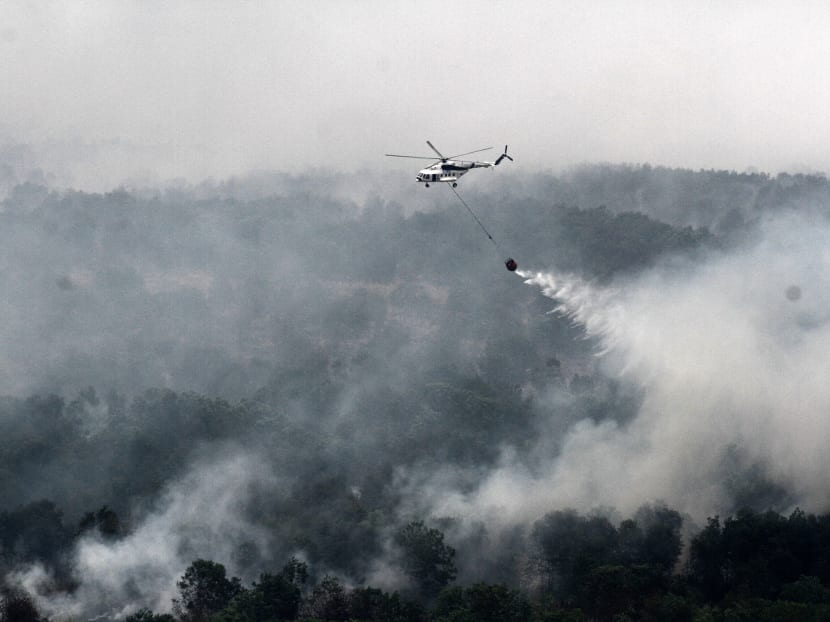S’pore, M’sia dismiss study’s claim that haze caused over 100,000 premature deaths
SINGAPORE — The authorities in Singapore and Malaysia have dismissed a study, which claimed the Indonesian forest fires that choked a swathe of South-east Asia with a smoky haze for weeks last year may have caused more than 100,000 premature deaths in the region.
SINGAPORE — The authorities in Singapore and Malaysia have dismissed a study, which claimed the Indonesian forest fires that choked a swathe of South-east Asia with a smoky haze for weeks last year may have caused more than 100,000 premature deaths in the region.
The study, which was conducted by scientists from Harvard University and Columbia University, is due to be published in the journal Environmental Research Letters.
The number of deaths is an estimate derived from a complex analysis that has not yet been validated by analysis of official data on mortality. The study said there is a high statistical probability that premature deaths ranged between 26,300 and 174,300. Its main estimate of 100,300 deaths is the average of those two figures. It projected 91,600 deaths in Indonesia, 6,500 in Malaysia and 2,200 in Singapore.
Commenting on the study, a Singapore Ministry of Health (MOH) spokesperson on Monday (Sept 19) noted that the study “attempts to estimate the number of people who had premature deaths due to haze”.
“Such modelling studies are based on various assumptions. The validity of these assumptions influences greatly the accuracy of the estimates,” the spokesperson said. “We note that the modelling study does not take into consideration the mitigating measures that were implemented by countries affected by the haze. Hence, it is not reflective of the actual situation.”
The MOH pointed out that the age-standardised death rate in Singapore was not higher last year, compared with 2010 to 2014. In fact, the rate dipped steadily over the six years — from 3.6 in 2010 and 2011, to 3.2 last year.
The MOH spokesperson said that for healthy individuals, short-term exposure to haze will “generally not cause any major health issues, other than irritation of the eyes, nose, and throat”. Nevertheless, haze particles can affect the heart and lungs, especially in people who already have chronic heart or lung disease.
The study — which was hailed by environmental group Greenpeace as “groundbreaking” — considered only the health impact on adults and restricts itself to the effects of health-threatening fine particulate matter, often referred to as PM2.5, rather than all toxins that would be in the smoke from burning peatlands and forests.
Dr Lee Yeow Hian, a respiratory and sleep physician at Mount Elizabeth Novena Hospital, noted the difficulty in attributing deaths to haze “especially for people who already have pre-existing conditions like heart disease, or stroke”. Nevertheless, he said it would be interesting to compare the number of deaths from various causes such as heart disease, diabetes and stroke in the last decade or so — when haze became a problem — with the earlier years. “If there is an increasing trend then maybe we can attribute some of it to the haze,” he said.
Prof Philip Eng, a senior consultant respiratory and ICU physician at Mount Elizabeth Hospital, said the Harvard and Columbia study pointed out “some very important facts”: Among other things, air pollution is a major cause of mortality and while it is difficult to accurately link seasonal short-term fluctuations in PM2.5 levels to mortality, there is certainly a “linear correlation”, he said. “There should be more research (on) how to lower the average PM2.5 levels,” Prof Eng said.
A spokesman for Indonesia’s environment ministry did not immediately have any comment on the study. Malaysia health ministry’s deputy director-general S Jeyaindran said his country did not have any haze-related deaths. “No such thing,” he told The Star Online. “We had no deaths last year directly related to the haze. We had increased number of conjunctivitis and respiratory track infections but it’s mostly due to the fact that some haze contained sulpher dioxide and nitric oxide which comes from the burning of fossil fuel.”
Mr Rajasekhar Bala, an environmental engineering expert at the National University of Singapore, was one of five experts who reviewed the paper and were not involved in the research. He said that even with caveats, the study should serve as a “wake-up call” for firm action in Indonesia to curb peatland and forest fires and for regional cooperation to deal with the fallout on public health.
The fires from July to October last year in southern Sumatra and the Indonesian part of Borneo were the worst since 1997 and exacerbated by El Nino dry conditions. About 261,000ha of land were burned. Some of the fires started accidentally but many were deliberately set by companies and villagers to clear land for plantations and agriculture. WITH AGENCIES







